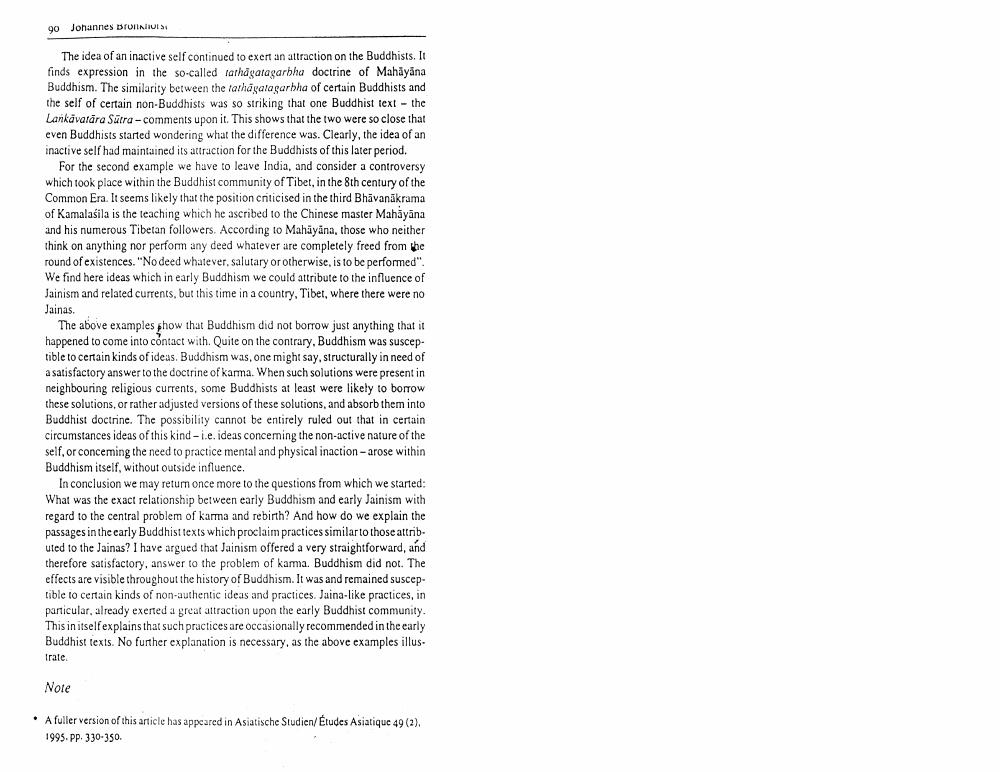Book Title: Buddha And Jainas Reconsidered Author(s): Johannes Bronkhorst Publisher: Johannes Bronkhorst View full book textPage 3
________________ 90 Johannes Bronno The idea of an inactive self continued to exert an attraction on the Buddhists. It finds expression in the so-called tathagatagarbhu doctrine of Mahayana Buddhism. The similarity between the lathagaiagarbha of certain Buddhists and the self of certain non-Buddhists was so striking that one Buddhist text - the Lankavatara Sutra - comments upon it. This shows that the two were so close that even Buddhists started wondering what the difference was. Clearly, the idea of an inactive self had maintained its attraction for the Buddhists of this later period. For the second example we have to leave India, and consider a controversy which took place within the Buddhist community of Tibet, in the 8th century of the Common Era. It seems likely that the position criticised in the third Bhavanakrama of Kamalasila is the teaching which he ascribed to the Chinese master Mahayana and his numerous Tibetan followers. According to Mahayana, those who neither think on anything nor perform any deed whatever are completely freed from the round of existences. "No deed whatever, salutary or otherwise, is to be performed". We find here ideas which in early Buddhism we could attribute to the influence of Jainism and related currents, but this time in a country, Tibet, where there were no Jainas. The above examples show that Buddhism did not borrow just anything that it happened to come into contact with. Quite on the contrary, Buddhism was susceptible to certain kinds of ideas. Buddhism was, one might say, structurally in need of a satisfactory answer to the doctrine of karma. When such solutions were present in neighbouring religious currents, some Buddhists at least were likely to borrow these solutions, or rather adjusted versions of these solutions, and absorb them into Buddhist doctrine. The possibility cannot be entirely ruled out that in certain circumstances ideas of this kind-i.e. ideas concerning the non-active nature of the self, or conceming the need to practice mental and physical inaction - arose within Buddhism itself, without outside influence. In conclusion we may return once more to the questions from which we started: What was the exact relationship between early Buddhism and early Jainism with regard to the central problem of karma and rebirth? And how do we explain the passages in the early Buddhist texts which proclaim practices similar to those attributed to the Jainas? I have argued that Jainism offered a very straightforward, and therefore satisfactory, answer to the problem of kamma. Buddhism did not. The effects are visible throughout the history of Buddhism. It was and remained susceptible to certain kinds of non-authentic ideas and practices. Jaina-like practices, in panicular, already exerted a great attraction upon the early Buddhist community. This in itselfexplains that such practices are occasionally recommended in the early Buddhist texts. No further explanation is necessary, as the above examples illusTrate. Noie * A fuller version of this article has appeared in Asiatische Studien/Etudes Asiatique 49 (2), 1995. PP. 330-350.Page Navigation
1 2 3
